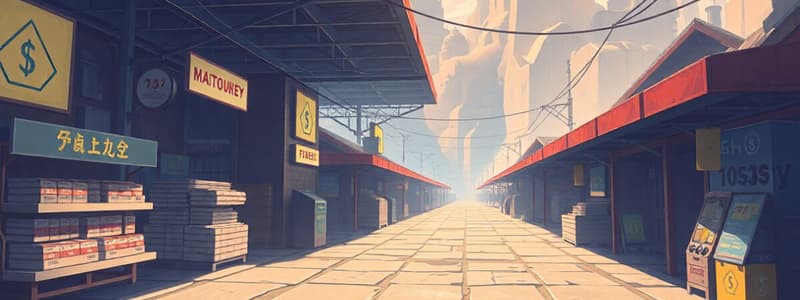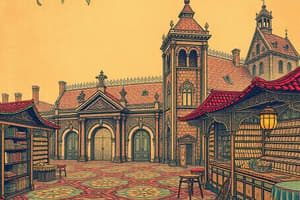Podcast
Questions and Answers
Economics is primarily concerned with the study of what?
Economics is primarily concerned with the study of what?
- Literary analysis
- The allocation of scarce resources (correct)
- Political systems
- Historical events
What does microeconomics primarily focus on?
What does microeconomics primarily focus on?
- Government budget deficits
- International trade policies
- Individual economic agents (correct)
- The economy as a whole
In economics, what is 'market equilibrium'?
In economics, what is 'market equilibrium'?
- A period of economic recession
- The point where supply and demand intersect (correct)
- Government regulation of prices
- A surplus of goods
What is GDP primarily used to measure?
What is GDP primarily used to measure?
What is inflation?
What is inflation?
What does fiscal policy involve?
What does fiscal policy involve?
Which economic system is characterized by private ownership of the means of production?
Which economic system is characterized by private ownership of the means of production?
What is economic development primarily concerned with?
What is economic development primarily concerned with?
What does the unemployment rate measure?
What does the unemployment rate measure?
What are externalities?
What are externalities?
Flashcards
Economics
Economics
The study of how societies allocate scarce resources to satisfy unlimited wants and needs.
Microeconomics
Microeconomics
Focuses on individual economic agents like households and firms.
Supply and Demand
Supply and Demand
A model showing how prices and quantities are set in competitive markets.
Elasticity
Elasticity
Signup and view all the flashcards
Externalities
Externalities
Signup and view all the flashcards
Public Goods
Public Goods
Signup and view all the flashcards
Macroeconomics
Macroeconomics
Signup and view all the flashcards
Gross Domestic Product (GDP)
Gross Domestic Product (GDP)
Signup and view all the flashcards
Fiscal Policy
Fiscal Policy
Signup and view all the flashcards
Capitalism
Capitalism
Signup and view all the flashcards
Study Notes
- Economics is a social science that studies the production, distribution, and consumption of goods and services
- It analyzes how individuals, businesses, governments, and societies make choices to allocate scarce resources to satisfy their wants and needs
Microeconomics
- Microeconomics focuses on the behavior of individual economic agents, such as households, firms, and markets
- Supply and demand is a model that explains how prices and quantities are determined in competitive markets
- Market equilibrium occurs where the supply and demand curves intersect, determining the equilibrium price and quantity
- Elasticity measures the responsiveness of one variable to a change in another, such as price elasticity of demand
- Market structures include perfect competition, monopolistic competition, oligopoly, and monopoly, each with different characteristics and implications for market outcomes
- Production costs include fixed costs, variable costs, total costs, average costs, and marginal costs
- Firms aim to maximize profits by producing at the level where marginal revenue equals marginal cost
- Market failures occur when markets fail to allocate resources efficiently, leading to suboptimal outcomes
- Externalities are costs or benefits that affect parties not involved in a transaction, leading to market inefficiencies
- Public goods are non-excludable and non-rivalrous, leading to the free-rider problem
Macroeconomics
- Macroeconomics examines the behavior of the economy as a whole, focusing on aggregate variables such as GDP, inflation, and unemployment
- Gross domestic product (GDP) measures the total value of goods and services produced within a country's borders during a specific period
- Inflation is the rate at which the general level of prices for goods and services is rising, and subsequently, purchasing power is falling
- Unemployment refers to the number of people who are actively seeking employment but are unable to find work
- Fiscal policy involves the use of government spending and taxation to influence the economy
- Monetary policy involves the central bank manipulating the money supply and interest rates to influence economic activity
- Economic growth refers to the increase in the production of goods and services in an economy over time
- Business cycles are fluctuations in economic activity, characterized by periods of expansion and contraction
- International trade involves the exchange of goods and services between countries
- Exchange rates determine the value of one currency in terms of another, influencing international trade and investment flows
Economic Systems
- Capitalism is an economic system characterized by private ownership of the means of production and the allocation of resources through markets
- Socialism is an economic system characterized by social ownership of the means of production and the allocation of resources through planning
- Mixed economies combine elements of both capitalism and socialism, with varying degrees of government intervention in the economy
- Traditional economies are based on customs, traditions, and historical precedents, with limited use of markets or government intervention
- Command economies are characterized by central planning, with the government making most economic decisions
Economic Development
- Economic development refers to the process of improving the standard of living in a country, including economic growth, poverty reduction, and improvements in health and education
- Poverty is the state of being poor, measured by income, consumption, or other indicators of well-being
- Inequality refers to the unequal distribution of income, wealth, or opportunities among individuals or groups in a society
- Human capital refers to the skills, knowledge, and experience possessed by individuals, which contribute to economic productivity
- Foreign aid involves the transfer of resources from developed to developing countries, aimed at promoting economic development
- Sustainable development seeks to meet the needs of the present without compromising the ability of future generations to meet their own needs
- Globalization refers to the increasing integration of economies through trade, investment, and migration
Key Economic Indicators
- GDP growth rate measures the percentage change in GDP from one period to another
- Inflation rate measures the percentage change in the general price level from one period to another
- Unemployment rate measures the percentage of the labor force that is unemployed
- Interest rates are the cost of borrowing money, expressed as a percentage
- Exchange rates determine the value of one currency in terms of another
- Consumer confidence index measures consumers' feelings about the economy and their spending plans
- Purchasing Managers' Index (PMI) is an indicator of the economic health of the manufacturing sector
- Government debt measures the total amount of money owed by the government
Studying That Suits You
Use AI to generate personalized quizzes and flashcards to suit your learning preferences.




